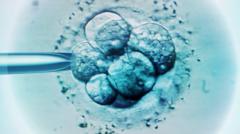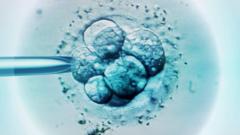US scientists have, for the first time, made early-stage human embryos by manipulating DNA taken from people's skin cells and then fertilising it with sperm.
This technique could overcome infertility due to old age or disease, by using almost any cell in the body as the starting point for life.
It could even allow same-sex couples to have a genetically related child.
However, significant refinements are needed before it’s ready for fertility clinics.
The Oregon Health and Science University research team's technique takes the nucleus, which contains a complete genetic blueprint, out of a skin cell.
The nucleus is then placed inside a donor egg that has had its own genetic information removed. So far, this method resembles that used to clone Dolly the Sheep in 1996.
The study published in the journal Nature Communications revealed 82 functional eggs were fertilised and some advanced to early embryonic stages, although none developed past six days.
Critically, the technique requires the egg to discard half of its chromosomes, necessitating further refinement in this area as the current process can be unreliable.
This technology also opens the door for same-sex couples to use skin cells from either partner to create a child genetically related to both.
As discussions continue, experts emphasize the importance of transparent communication with the public regarding advancements in reproductive science.














